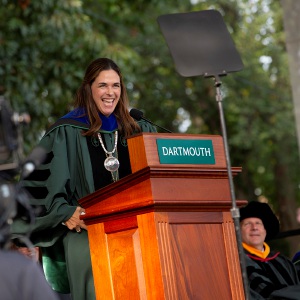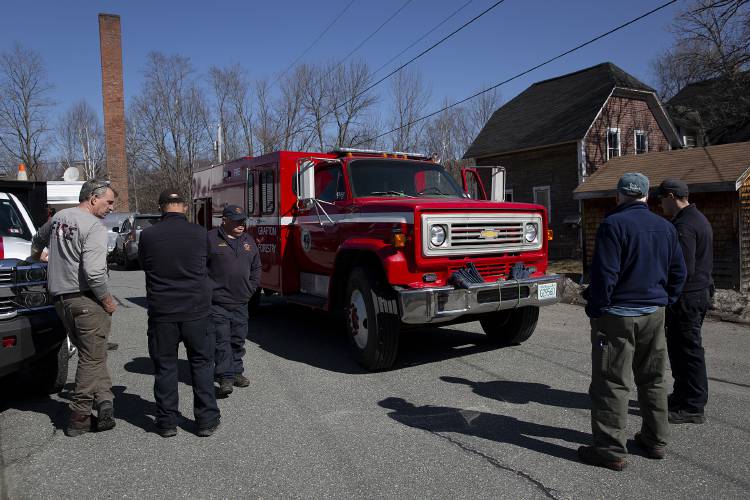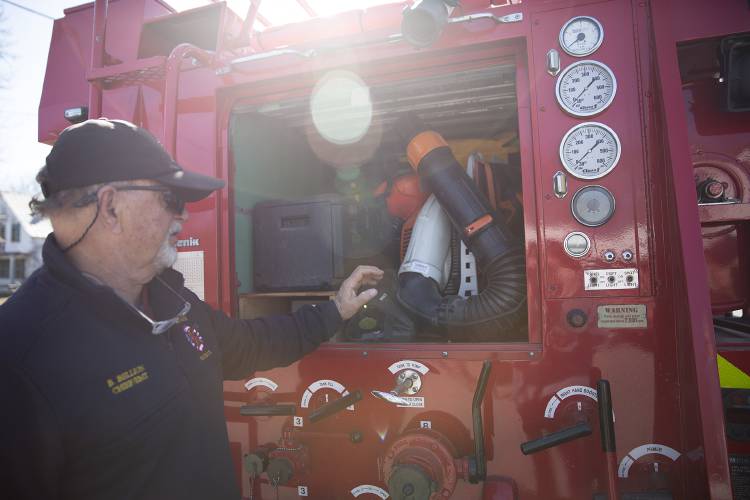Upper Valley fire departments prepare as wildfire season lengthens
|
Published: 03-28-2025 3:01 PM
Modified: 03-30-2025 1:32 PM |
CANAAN — Canaan and Grafton fire departments responded to their first brushfire of the season earlier this month, when a perfect storm of wind and weather conditions spread a backyard fire onto a dry hillside.
Canaan Fire Capt. Bill Bellion, a former chief, said the March 15 fire set to burn a brush pile at a home on State Route 118 was relatively small, “under a half acre, if that,” but it marks an early start to the annual fire season.
“Normally that kind of weather we had is the first week in April or so, so it’s a couple weeks ahead,” Bellion said.
The small Canaan fire is just one example of changing trends around wildfire risk and intensity. In traditionally fire-prone regions of the United States, wildfires are coming faster and fiercer, and at a closer look, the Upper Valley may be no exception.
“Certainly I’m not a climate expert, I don’t pretend to be, but it does appear that there are more opportunities for brush fires,” Enfield Fire Chief and Upper Valley Mutual Aid Association Vice President Phil Neily said in a recent interview. “… We lose the snow, it’s not going to take long before every department is going to be geared up thinking about that response, and it seems to be coming quicker.”
So far this year, there have already been multiple brush fires in New Hampshire reported to the National Interagency Fire Center, which tracks wildland fire incidents. None have been reported in Vermont, but elsewhere in New England, there have been more than 100 brush fires in Massachusetts and about 30 in Maine.
Most of the fires occurred ahead of the region’s typical fire season, which Vermont State Forest Fire Supervisor Dan Dillner said runs from about mid-March through November.
“I don’t think we necessarily need to show that we’re getting more fires in Vermont to say that there’s more potential looking at what’s happening around us,” Dillner said.
Article continues after...
Yesterday's Most Read Articles
 Lebanon to close street, block parking to allow outdoor dining
Lebanon to close street, block parking to allow outdoor dining
 Hundreds of alumni sign letter urging Beilock, Dartmouth to make a stand for academic freedom
Hundreds of alumni sign letter urging Beilock, Dartmouth to make a stand for academic freedom
 Tree-clearing work near power lines causes Upper Valley outage
Tree-clearing work near power lines causes Upper Valley outage
 Outgoing Alice Peck Day CEO led hospital through growth and change
Outgoing Alice Peck Day CEO led hospital through growth and change
 Grantham superintendent resigning to become EMT amid rising political attacks on schools
Grantham superintendent resigning to become EMT amid rising political attacks on schools
Worldwide, “extreme wildfire activity” has more than doubled over the past two to three decades due to climate change, according to NASA reporting. Fire seasons are also extending earlier in the spring and later in the fall.
In January a series of fires devastated Los Angeles County, California. The two largest — the Eaton and Palisades Fires — both began Jan. 7 and were the second and third most destructive wildfires in California history, collectively burning over 37,000 acres and causing 28 deaths, according to the Western Fire Chiefs Association.
While there has not been a “great” statistical increase in the number of wildfires year over year in Vermont, Dillner said there was certainly an increase last fall.
There were 38 wildfires in October and November, compared to three in the same months in 2023, according to data from the Vermont Department of Forests, Parks and Recreation. The agency also reported that the acreage burned in October and November was 18 times higher than the 25-year average for those months.
Driving up this number was an October fire in Barnard that Dillner said burned 57 acres, much more than Vermont’s 10-year average brush fire size of less than 2 acres.
One factor increasing the number and severity of wildfires in the Upper Valley, Dillner said, is that there is “more precipitation in fewer events” causing longer dry periods. Last year, Dillner said, the summer was very wet but in September there was “virtually no rain” and days with “tremendous amounts of wind and low humidity.”
As drought increases in warmer climates everywhere it is “going to be marginally more damaging than it would have been in a cooler climate,” climate scientist and Dartmouth professor Justin Mankin said.
“You’re just loading the dice in having any dry interval also be a warm interval and that’s the combination that makes these droughts more damaging … and to setting up the kind of ecosystem stress that would prime the landscape for an ignition and associated wildfire,” Mankin said.
But, Mankin and Dillner were quick to emphasize that some of the natural ecosystem and features of the Upper Valley make it less prone to widespread long-term wildfires than areas like California, even as the climate shifts.
“New England and New England forests are not the same as (the West) and western forests,” Mankin said. “Anyone who’s from New England and spent time outside and travels to national parks out west can see that difference in physiology and climate and how that gets reflected.”
New England does not have a distinct wet and dry season, Mankin said, so if “you miss a wet month in New England you maybe don’t get widespread drought.” There is also more “latent humidity” and the landscape “has more water on it.”
Global climate change has also been “enhancing precipitation” in the Northeast United States, which in some ways could decrease wildfire risk but that precipitation is also consolidated into heavier events and the impact is not well understood.
“That in no way suggests that there is not wildfire risk in New England and that that wildfire risk shouldn’t be taken seriously,” Mankin said.
Another unique feature of the Upper Valley, Dillner said, is that almost all wildfires in Vermont are human caused, so they are less likely to be extremely remote. As fires grow in size, time or distance from society, departments rely on mutual aid networks and eventually state resources for assistance.
Dillner’s department, the wildland fire control program under Vermont’s Agency of Natural Resources, is a small force with a range of wildfire management responsibilities. These include reporting fire weather and other data, distributing resources like federal funds and training to local departments, raising public awareness and providing backup for major wildfires, Dillner said.
“Wildfires aren’t like a lightning strike. They’re somewhat more predictable in terms of the conditions; we won’t just be all of a sudden surprised that there’s a fire,” Dillner said.
While the possibility of a catastrophic wildfire burning tens of thousands of acres in the Upper Valley may be low even as the climate changes, regional emergency services are still preparing given recent trends.
As part of basic firefighter training, officers learn “forestry specific fire behavior and fire weather,” how to use specialized equipment and essential techniques for fighting a forest fire in this region such as digging trenches to block the fire’s path, New Hampshire Fire Academy Assistant Director Jeffrey Phillips said in a Tuesday interview.
Over the last several years, Upper Valley Mutual Aid’s Straight said many departments have bought more specialized wildfire-fighting equipment and have systems in place to track regional resources. He said it is clear that things are changing and this is reflected in the number of large wildfires that need more widespread assistance.
“When that big incident happens, all towns have stuff in place so all they have to do is get on the radio,” Straight said.
Many of the 48 departments that are part of the Upper Valley Mutual Aid network report and track the equipment that they have and share this with the network. Some departments even have special forest fire “run cards” — the documents that dictate which departments are called in for mutual aid and in what order — that list certain departments’ specialized equipment so firefighters can quickly call for the right backup, Straight said.
“I’m a firm believer in let’s not have every department have the same exact equipment,” he said.
One department that has been accruing special equipment, including a forestry fire engine, all-terrain vehicles and side-by-side utility vehicles is the Enfield Fire Department, Neily, the department’s chief, said. The forestry truck is equipped with four-wheel-drive to travel over difficult terrain and carries hoses and 150 gallons of water.
Wildfire response is mostly about being proactive and prepared for the “worst case scenario,” Neily said. This includes knowing ahead of time where water sources are and how they might be impacted by a drought, continuously training and analyzing fire responses and raising public awareness.
“We need to be sure that no matter what the situation is that we have the resources to be able to effectively handle the emergency,” Neily said.
The biggest factor limiting Upper Valley departments’ ability to respond to large wildfires is actually the lack of firefighters and interested recruits, both Neily and Straight said.
“Unless it’s a little campfire, there’s not a department around here that I know of that has enough man power to really fight a good-sized brush (or) wildfire by themselves and that’s why we have mutual aid departments,” Straight said.
For the upcoming fire season, “normal significant fire potential” is forecast for the Eastern United States, but drought conditions could increase forest fire risk and an early start to the spring fire season is possible, according to a forecast for March through June 2025 from the National Interagency Fire Center.
Currently, all of the Upper Valley is experiencing abnormally dry to moderate drought conditions, according to the U.S. Drought Monitor.
Burn permits are required in most towns when there is not snow on the ground. Residents should contact their town forest fire warden to get a burn permit.
Clare Shanahan can be reached at cshanahan@vnews.com or 603-727-3216.








 Dartmouth doctoral student back on campus after visa status was thrown into doubt
Dartmouth doctoral student back on campus after visa status was thrown into doubt
